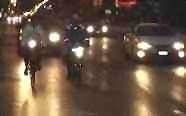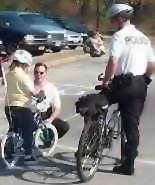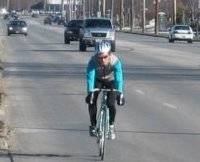
|
SPECIAL HAPPENINGS 2007 FFBC Annual Holiday PartyDate Sunday, Dec 9, 2007, 5:30PM to 9:30PM Soft drinks and hors d’oeuvres provided by the club. Please bring your own adult refreshments - beer, wine, etc. Food Assignment White Elephant Exchange You can stay and enjoy the white elephant exchange even if you don't contribute a white elephant. There is a RSVP on the e-vite or you can respond to Susan and Florence. Their telephone numbers are listed above. The FFBC Cinderella Training Series is finalized for 2008 The goals of the Cinderella Training Rides are to provide women with the necessary knowledge to ride a bicycle safely and with confidence in a group setting and to enable them to develop the necessary skills to enjoy and complete the Cinderella Classic, a 100-kilometer bicycle ride for women only, an event sponsored by the Valley Spokesmen Bicycle Club. During the Series, the courses and training rides are designed so that participants can build strength, endurance and confidence by developing team riding and mechanical skills with encouragement and tips from other women cyclists. The tentative schedule calls for the Series to be kicked off on Saturday January 18, 2008 with the Orientation, Bike Rodeo and a short ride. Each week to follow, rides of increasing distance and difficulty will be scheduled. For the training rides, experienced ride leaders will lead small groups of 10-15 cyclists each. They will be there to encourage all riders and to provide answers and tips so that all can possess the needed skills. Ultimately the training will prepare the participants to partake in the Cinderella Classic, scheduled on April 5, 2008. Details of the requirements and how to register for the Training and the Classic will be provided by the Training Committee, once they are finalized. If you are interested in participating in the Cinderella Training Series, please go to our website at www.ffbc.org/cinderella2008.html for details and updates. For more information, please contact Lori Sommer by email at lmsommer@sbcglobal.net or Florence Silver by phone at 510-651-1411. We are always looking for ride leaders to provide encouragement and guidance for the novice riders participating in the training. If you are interested in helping out as a ride leader, please contact Judy Young at 510-487-2309 or by email at sjsyoung3@comcast.net. Is Riding a Century in 2008 your New Year Resolution? Come Join the Progressive Rides The club will be starting its Progressive Rides again in 2008– a series of increasingly strenuous rides aimed at developing the endurance necessary for completing 100-mile rides. The rides will commence on January 13 and culminate with the Primavera Worker's Ride on Saturday, April 12. There are enough weeks in this year's schedule to make the weekly increases gradual. No rainouts will be reschedule, though they can be scheduled as regular club rides should they be cancelled. People should be able to miss a week here or there and still keep up (provided you keep up with your training). Those of you who are just touching up your fitness for the New Year should be able to choose those rides you want to do and survive just fine. For the 2008 Progressive Rides, the distances are based on the assumption that you can ride the Calaveras loop before starting the series. The first ride will lengthen to 45 miles, and is intended to challenge you but is absolutely doable if you can do Calaveras. If you're not sure you're ready, get your training started now and you should be all set to go come the beginning of January. You can check your readiness by doing the First Saturday ride on January 6. Call or email me with questions, if you wonder if you can manage, or can't find someone to give you some training advice. As I am planning to lead the Moderate-Pace rides, I am looking for volunteers to lead the Brisk-Pace equivalent rides to provide options for all cyclists. I look forward to making new riding friends. Eric Dittmar. 510-579-7337, ericdit@gmail.com Bicycle Blunders and Smarter Solutions (continuing article submitted by Wynn Kagayama) 8. Smarter Solutions -- Education and Advocacy We need to educate society at all levels to overcome the misinformation that has been dispensed for several generations. Educational measures include:
An extremely dangerous and very common mistake made by cyclists is riding at night without the proper lights -- often without any lights. It is for good reason that all states require a headlight on a bicycle used at night. Note in the top photo the bike headlights are plainly visible but otherwise, the two cyclists are inconspicuous despite several reflective items on their bikes and clothing. Unfortunately, most night-time cyclists do not know enough to use lights. The Consumer Products Safety Commission is largely to blame for this problem because they mandate a set of reflectors for bikes but they do not mandate lights, a standard mounting system for lights or even a hang-tag to warn consumers that lights are needed at night. Only one of the required reflectors provides a significant safety benefit (the rear one) and that one is not nearly as bright as a standard SAE auto reflector. The other reflectors are nearly worthless. Most states' bicycle laws mandate these nearly-useless reflectors. Many Novices are misled by all the reflectors, which seem to serve as safety equipment. Bicycle manufacturers lobbied for the reflector requirements, rather than lights. Therefore the manufacturers are also culpable for the low usage of proper lighting. Even in daytime most people who use bicycles do it badly. Earlier, we showed how nearly everyone has been exposed to misinformation about cycling. We have a huge problem to overcome. People in our society must understand that bicycles are vehicles that should be operated on the same roads, by the same rules and with the same rights as other vehicles. Horsepower and speed do not confer superior rights. Using pedestrian methods (unless limited to pedestrian speeds) is extremely dangerous. The standard rules of the road were developed to allow safe and efficient travel for all. Transportation engineers and planners whose work affects cyclists must understand the best methods of bicycle operation. Their designs must encourage -- and certainly not discourage -- these best practices. Teaching Children
One popular means for teaching children is at a bicycle rodeo as shown at right. If the community has a police bike patrol, the officers should be involved. Rodeos can be beneficial as small part of a larger program if the people teaching are knowledgeable. Perhaps the best benefit of a rodeo is it may offer an opportunity to reach the parents and distribute a parents' guide. A much better way to teach children [1] is to train several instructors in a certified program and then use them to teach groups of children through a school or youth organization. The instructors must be thoroughly trained in bicycle driving so they avoid the usual mistakes. We should emulate the Red Cross water safety program, which employs well-trained instructors who work from a carefully designed syllabus instead of untrained authority figures who make up advice as they go. Cycling advocacy organizations must work to disseminate information widely to overcome dangerous myths about bicycle operation. One way to teach society is a series of well-written and frequently played public service announcements in the media (radio, television and newspapers). We must also reach authority figures, police, teachers and police so they stop spreading misinformation but instead begin to encourage the proper techniques. Child learning left merge Ultimately, parents must learn to appreciate correct cycling techniques so they do not miseducate their children or oppose efforts to provide proper lessons. This means society at large must have a basic understanding. As soon as a child learns to steer and balance a bicycle, parents should start teaching the basics of bicycle driving. With competent teaching, children of about age seven or eight can ride safely on residential streets. The seven year old in the photo at right is demonstrating correct technique to prepare for a left turn -- scan, yield and left merge. She is on a quiet street suitable for her age. By about age ten, she should be ready for four lane streets with moderate traffic and by twelve, for nearly any road. This author has a PowerPoint Slideshow for parents that you can access on the LAB Reform Cycling Education Pages. The show can help you teach your children the best and safest practices. Teaching Adults The most through bicycle driving program ever developed for either adults or children, is Effective Cycling training. This was based on the book Effective Cycling [2]. Although these classes are not currently being offered, the shorter 9-10 hour BikeEd "Road I" course [3] was derived from the original 30 hour course. For less extensive training, there is an Effective Cycling video [4] and this author offers a "Bicycle Driving Seminar" PowerPoint presentation. We need to reach everyone with the essential message that bicycles are vehicles that should be operated on the same roads, by the same rules and with the same rights and responsibilities as other vehicles. If we can get this message broadly distributed, then there will be far fewer bicycle blunders and people will be more receptive to the idea of bicycle driving lessons. Beneficial Advocacy
Traditional "bike safety" teaches cyclists to stay out of the way of cars. This encourages bad lane position. When other drivers are passing too close, cyclists need to know to move left (further into the traffic lane) to show that the passing motorist must use the next lane to pass. If you "hug the curb" you invite them to "squeeze by". On a road with narrow lanes, the left tire track is often a good place to ride, as demonstrated in the photo at right. Riding further left has other safety advantages as well: (1) The cyclist is where other drivers are looking for traffic, thus more likely to be seen. (2) Staying further left maintains a safety zone to the right. (3) The road surface is usually in better shape away from the edge of the road. We have sharply criticized "bicycle advocates" for ulterior motives in promoting bicycling. Their misplaced advocacy makes cycling more dangerous and more difficult and it threatens our right to use the roads. Actually, bicycles need no advocates; they are only machines. Bicycles are not concerned whether communities are "bicycle friendly". However cyclists do need knowledgeable friends who will teach the best practices, reform bad traffic laws and protect their rights. If we are to get people to cycle effectively, we must teach them the "secret" of good road position. There are organizations that provide beneficial advocacy. We list a few below.
Footnotes [2] Effective Cycling, MIT Press, 1993 [3] See the list of Certified League Cycling Instructors, to arrange a course or to learn how to become certified yourself. [4] The Effective Cycling Video is available for $25 from League of American Bicyclists, phone 202 822-1333 or email to bikeleague@bikeleague.org. Please join us and help restore the BikeLeague to members. © Copyright 2004-2007 Fred Oswald. May be copied with attribution. |


